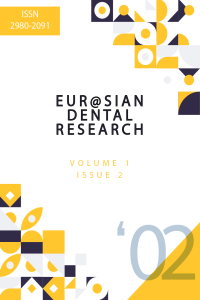Abstract
Aim Renal osteodystrophy, also known as uremic osteopathy, is a constellation of musculoskeletal abnormalities that occur in patients with chronic renal failure. Osteomalacia, Rickets, abnormal calcium and phosphate metabolism due to secondary hyperparathroidism are also related to this phenomenon. Bone changes are expected in renal osteodystrophy cases such as lamina dura loss, resorption of alveolar bone, multiple tiny radiolucencies on calvaria, subperiosteal resorption of bones and osteopenia.
Material and method In the first part of the study, cases who applied to the oral diagnosis and radiology department of our faculty with no known metabolic bone disease were evaluated. These cases were first divided into two separate groups according to gender, and each group was divided into seven different age groups. Age groups were determined as 0-14, 25-19, 20,-29, 30-39, 40-49, 50-59, and over 60 years of age.
Results In the statistical study, it was first investigated whether there was a significant difference between the age groups of both sexes. As a result of the research conducted with one-way analysis of variance, no statistically significant relationship was found between age groups in both genders. Furthermore, the values obtained from both sexes were checked with the t-test and no significant relationship was found.
Conclusion In the light of these findings, it was concluded that our method is a useful method in determining metabolic bone loss.
Keywords
References
- Kumar P, Clark ML. Kumar & Clark’s Cases in Clinical Medicine E-Book: Elsevier Health Sciences; 2020.
- Wallach JB. Interpretation of diagnostic tests: Lippincott Williams & Wilkins; 2007.
- El Demellawy D, Davila J, Shaw A, Nasr Y. Brief review on metabolic bone disease. Academic Forensic Pathology. 2018;8(3):611-40.
- Elder G. Pathophysiology and recent advances in the management of renal osteodystrophy. Journal of Bone and Mineral Research. 2002;17(12):2094-105.
- Aguilar A, Gifre L, Ureña-Torres P, Carrillo-López N, Rodriguez-García M, Massó E, et al. Pathophysiology of bone disease in chronic kidney disease: from basics to renal osteodystrophy and osteoporosis. Frontiers in Physiology. 2023;14:1177829.
- David V, Salusky IB, Malluche H, Nickolas TL. Renal osteodystrophy: something old, something new, something needed. Current Opinion in Nephrology and Hypertension.10.1097.
- Wani QA, Prayasi MS, Kumar M, Dar RM, Rai S, Misra D. Assessment of radiographic manifestations of teeth and jaw bones in chronic renal failure patients. Journal of Advanced Medical and Dental Sciences Research. 2023;11(6):138-41.
- Jalali P, Kim S. Multiple periradicular radiolucencies mimicking endodontic lesions in renal osteodystrophy of the mandible: a case report. International endodontic journal. 2016;49(7):706-14.
- Antonelli JR, Hottei TL. Oral manifestations of renal osteodystrophy: case report and review of the literature. Special care in dentistry. 2003;23(1):28-34.
- You M, Tang B, Wang Z-j, Wang K-l, Wang H. Radiological manifestations of renal osteodystrophy in the orofacial region: a case report and literature review. Oral Radiology. 2018;34:262-6.
- Moest T, Jahn AE, Heller K, Schiffer M, Adler W, Rohde M, et al. Peculiarities in the panoramic radiograph of patients with secondary hyperparathyroidism due to terminal renal disease: a radiologic controlled comparative study. Oral Radiology. 2023;39(1):125-32.
- Parthiban J, Asokan G, Prakash C, Varadharaja M. Oral manifestations in a renal osteodystrophy patient-a case report with review of literature. Journal of Clinical and Diagnostic Research: JCDR. 2014;8(8):ZD28.
- Silverman Jr S, Ware WH, Gillooly Jr C. Dental aspects of hyperparathyroidism. Oral Surgery, Oral Medicine, Oral Pathology. 1968;26(2):184-9.
- Ersu N, Şirin Sarıbal G, Tanyeri FZ, Amuk M. Evaluation of chronic renal failure with cone beam computed tomography radiomorphometric indices and fractal analysis in the mandible. Oral Radiology. 2023;39(1):133-42.
Abstract
References
- Kumar P, Clark ML. Kumar & Clark’s Cases in Clinical Medicine E-Book: Elsevier Health Sciences; 2020.
- Wallach JB. Interpretation of diagnostic tests: Lippincott Williams & Wilkins; 2007.
- El Demellawy D, Davila J, Shaw A, Nasr Y. Brief review on metabolic bone disease. Academic Forensic Pathology. 2018;8(3):611-40.
- Elder G. Pathophysiology and recent advances in the management of renal osteodystrophy. Journal of Bone and Mineral Research. 2002;17(12):2094-105.
- Aguilar A, Gifre L, Ureña-Torres P, Carrillo-López N, Rodriguez-García M, Massó E, et al. Pathophysiology of bone disease in chronic kidney disease: from basics to renal osteodystrophy and osteoporosis. Frontiers in Physiology. 2023;14:1177829.
- David V, Salusky IB, Malluche H, Nickolas TL. Renal osteodystrophy: something old, something new, something needed. Current Opinion in Nephrology and Hypertension.10.1097.
- Wani QA, Prayasi MS, Kumar M, Dar RM, Rai S, Misra D. Assessment of radiographic manifestations of teeth and jaw bones in chronic renal failure patients. Journal of Advanced Medical and Dental Sciences Research. 2023;11(6):138-41.
- Jalali P, Kim S. Multiple periradicular radiolucencies mimicking endodontic lesions in renal osteodystrophy of the mandible: a case report. International endodontic journal. 2016;49(7):706-14.
- Antonelli JR, Hottei TL. Oral manifestations of renal osteodystrophy: case report and review of the literature. Special care in dentistry. 2003;23(1):28-34.
- You M, Tang B, Wang Z-j, Wang K-l, Wang H. Radiological manifestations of renal osteodystrophy in the orofacial region: a case report and literature review. Oral Radiology. 2018;34:262-6.
- Moest T, Jahn AE, Heller K, Schiffer M, Adler W, Rohde M, et al. Peculiarities in the panoramic radiograph of patients with secondary hyperparathyroidism due to terminal renal disease: a radiologic controlled comparative study. Oral Radiology. 2023;39(1):125-32.
- Parthiban J, Asokan G, Prakash C, Varadharaja M. Oral manifestations in a renal osteodystrophy patient-a case report with review of literature. Journal of Clinical and Diagnostic Research: JCDR. 2014;8(8):ZD28.
- Silverman Jr S, Ware WH, Gillooly Jr C. Dental aspects of hyperparathyroidism. Oral Surgery, Oral Medicine, Oral Pathology. 1968;26(2):184-9.
- Ersu N, Şirin Sarıbal G, Tanyeri FZ, Amuk M. Evaluation of chronic renal failure with cone beam computed tomography radiomorphometric indices and fractal analysis in the mandible. Oral Radiology. 2023;39(1):133-42.
Details
| Primary Language | English |
|---|---|
| Subjects | Oral and Maxillofacial Radiology |
| Journal Section | Research Articles |
| Authors | |
| Publication Date | August 31, 2023 |
| Submission Date | August 8, 2023 |
| Published in Issue | Year 2023 Volume: 1 Issue: 2 |

